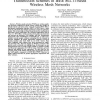Free Online Productivity Tools
i2Speak
i2Symbol
i2OCR
iTex2Img
iWeb2Print
iWeb2Shot
i2Type
iPdf2Split
iPdf2Merge
i2Bopomofo
i2Arabic
i2Style
i2Image
i2PDF
iLatex2Rtf
Sci2ools
113
click to vote
GLOBECOM
2010
IEEE
2010
IEEE
An Experimental Comparison of Burst Packet Transmission Schemes in IEEE 802.11-Based Wireless Mesh Networks
Abstract--Wireless mesh networks (WMNs) are wireless multihop networks comprised of mesh routers, which relay traffic on behalf of clients and other nodes. Using the standard IEEE 802.11 distributed coordination function (DCF) as MAC layer, a node needs to contend for the medium each time it wants to transmit a packet. This creates high overhead in particular for small packets and leads to poor performance for real-time applications such as Voice over IP (VoIP) or online gaming. Burst packet transmission can increase the efficiency. For example, with the Transmission Opportunity limit (TXOPlimit) in IEEE 802.11e, a station may transfer several packets without contending for the channel in between. Similarly, IP packet aggregation combines several IP packets together and sends them as one MAC Service Data Unit. Originally, both schemes have been developed for singlehop networks only. Thus the impact on WMNs is unclear if the packets need to contend over multiple hops. In this paper, we ...
| Added | 11 Feb 2011 |
| Updated | 11 Feb 2011 |
| Type | Journal |
| Year | 2010 |
| Where | GLOBECOM |
| Authors | Peter Dely, Andreas Kassler, Nico Bayer, Dmitry Sivchenko |
Comments (0)

